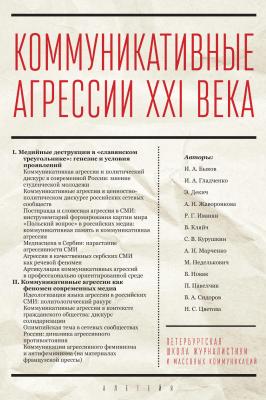ТОП просматриваемых книг сайта:
Коммуникативные агрессии XXI века. Коллектив авторов
Читать онлайн.Название Коммуникативные агрессии XXI века
Год выпуска 0
isbn 978-5-907189-84-3
Автор произведения Коллектив авторов
Жанр Культурология
Серия Петербургская школа журналистики и МК
Издательство Алетейя
Это не значит, что авторы предлагают коммуникативные агрессии воспринимать индифферентно, считая их некой нормой медийной жизни. Такой подход мы не приемлем, считаем, что высшей ценностью гуманистически ориентированных коммуникационных процессов является человек, его правдивое, неискаженное восприятие картины мира и свободное выражение им своего мнения, чему всегда препятствуют медийные деструкции. Именно поэтому их изучение всегда актуально для XXI века, объявленного столетием приоритета знаний о Человеке.
Структуру монографии образуют два раздела. Первый образовали главы, в которых анализируются деструктивные явления в медиа и их восприятие студенческой аудиторией так называемого «славянского треугольника» – Польши, России, Сербии. Главной задачей этого раздела стало установление генезиса и условий проявлений коммуникативных агрессий. Понятно, что содержание глав много шире обозначенных задач, но это только обогащает замысел Проекта.
Во втором разделе коммуникативные агрессии рассматриваются как феномен XXI века, триггерами которого становятся «внезапно» возникающие политические ситуации. География объектов изучения в главах этого раздела выходит за пределы «славянского треугольника», однако признаки коммуникативных агрессий неизменны. Эмпирический материал, изученный в главах второго раздела, и сделанные в нем выводы расширяют наше знание о природе коммуникативных агрессий – выявлены фазы функционирования, предшествующие непосредственной активизации деструкций в массовых коммуникациях. В результате формируется целостное представление о коммуникативных агрессиях как новом качестве уже известных информационных войн.
Summary
Communicative aggressions are attacks on the opponent done through media channels causing ideological, political, cultural and moral damage. Aggressions in the media environment in the form of the value-based conflict around “a symbol of belief” lead to political and cultural polarization of society and feed society with prejudices in relation to “otherness” – other way of thinking, other culture, other behavior.
In this collective monograph one can find the outcomes of the research implemented within the international project “Communicative Aggressions of the 21st Century” initiated by scientists of the partner universities from Russia and Poland, St. Petersburg State University (St.Petersburg State University) and the University of Adam Mickiewicz (UAM). Colleagues from the Belgrad university (Serbia) headed by professor V. V. Kljaic joined the project as well.
Empirical base of research, first of all, are results of survey of students of these universities, future journalists and experts in politics. The analysis of their understanding of media aggression allows to re-evaluate the conflict in the cross-cultural information perspective, in particular, in the context of the relations of Russia and Poland.
Importance of the research topic is defined by the features of the communicative aggressions which got intensified in the media environment of the certain countries and in general in the international community. Media aggression is present in all strata of society, first of all, due to activization of their presence in the network environment. Besides that aggressive intensions of media can resonate with mood of audience. Because of that agressivity in society gets intensified, or critical relation to media raises up.
Therefore the main objectives of the research initiated by researches from Poznan and St. Petersburg were: to analyze aggressive intensions of media and the attitude of the Polish students towards Russia and Russian ones – to Poland; to identify the factors strengthening the perception of media as a source of communicative aggressions. Scientific value of a research is defined through development of a concept of communicative aggressions, understanding the reasons why students look at media propaganda as aggression source, the analysis of a media stereotype “russophobia” which stirs up aggression of audience. The practical value is measured by the outcomes: 1) heteronymic trends in media and their student’s audience – the Polish and Russian students tuned towards Russia and Poland more considerate or, more often, neutrally, in contrary to negativism of political publications in media;

